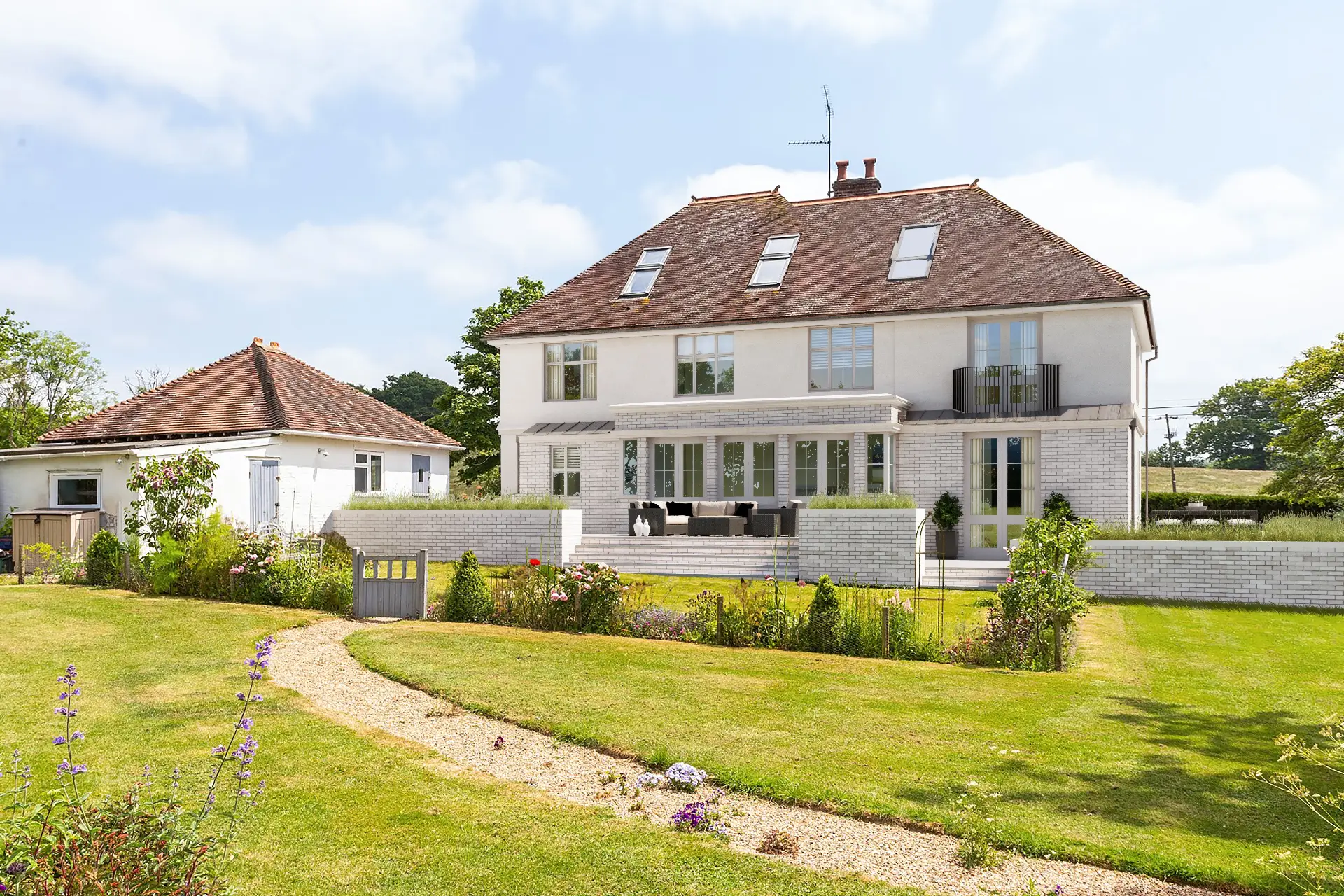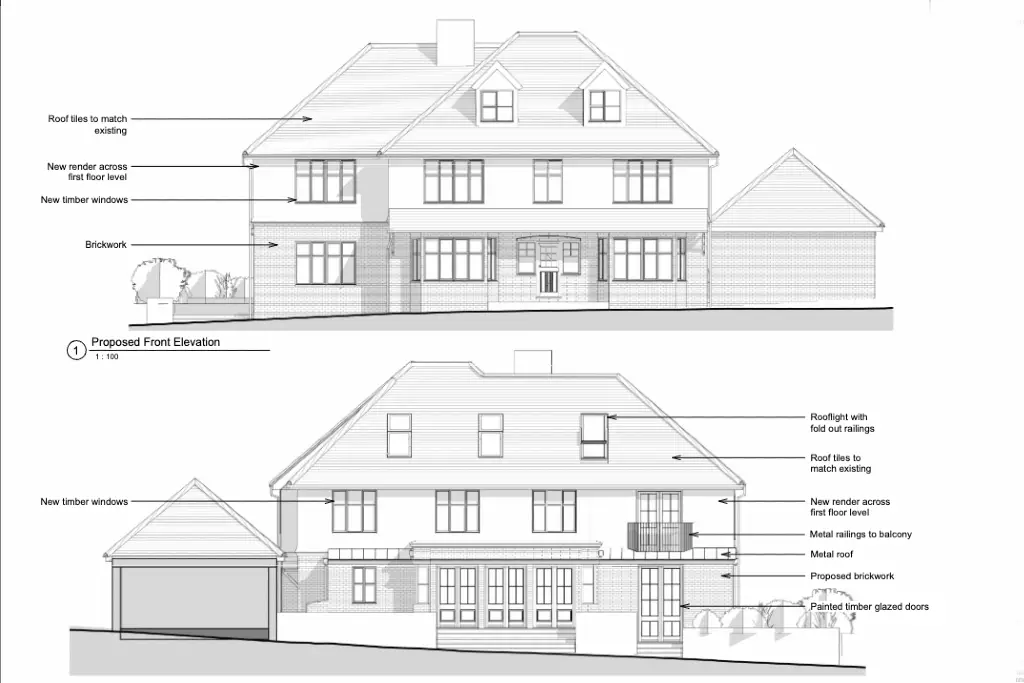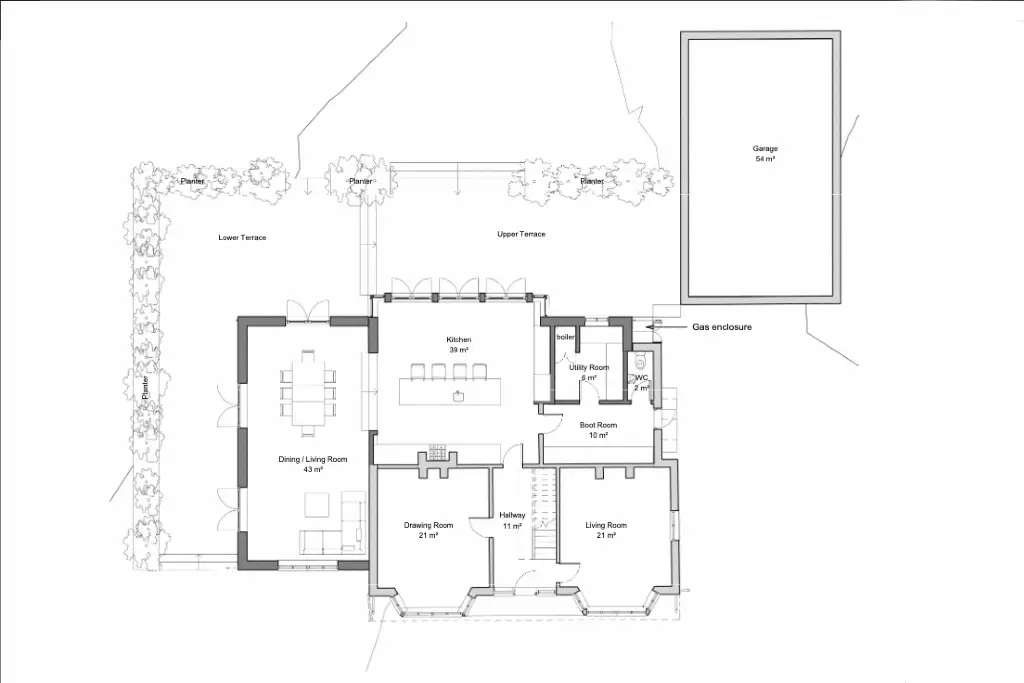
Two-Storey Side Extension To A 1930s House In Kent
We designed a bold yet sensitive two-storey side extension and a rear addition to increase space, light, and modern liveability in a 1930s house in Kent.
Our clients, a young family relocating to Kent from London, approached us to reimagine Bridge House, a gorgeous 1930s home immersed in the countryside. They were looking to expand the interior and open up the house to its remarkable landscape setting.
To meet the brief, we designed a two-and-a-half-storey side extension and a single-storey rear addition that increase the home’s footprint by 50%. The result is a scheme that honours the building’s original character while significantly improving spatial flow, natural light, and functionality.
Bridge House, A 1930s House In The Kent Countryside
Bridge House sits on a generous plot by the village of Goudhurst, in the borough of Tunbridge Wells. The property includes open fields, hedgerows, a pond, and established trees and lies opposite the boundary of the High Weald Area of Outstanding Natural Beauty. However, the site is not within a conservation area, and the property is neither listed nor deemed of special architectural significance.
Built in the 1930s, the house features white-painted brickwork and a traditional, compartmentalised layout typical of the period. The ground floor, for example, includes a central hallway flanked by a drawing room and dining room, with a separate kitchen to the rear.
The Brief For A 1930s House Extension
The clients hired James Clague Architects to create a home that better suited their growing family and took greater advantage of the site’s exceptional views.
They asked us to design a sensitive yet spacious extension to increase the footprint of the original 1930s house without overwhelming it. The brief called for high-quality materials, traditional detailing, and improved internal flow, particularly in the kitchen, which previously felt cut off from the landscape.
The Design: A Double Storey Side Extension And a Rear Addition
Our design introduces a two-and-a-half-storey side extension and a single-storey rear addition that integrate seamlessly with the existing structure and significantly increase internal space by approximately 50%.
Positioned to the southwest - the least sensitive side of the house - the additions are set back from the main elevation and neighbouring boundaries to maximise privacy and views. We also reduced their roofline to ensure they sit comfortably alongside the original house.
Inside, we turned the site’s natural slope into an opportunity by introducing a gentle split-level between the kitchen and the new living and dining area. This created a subtle separation while maintaining a sense of openness and flow.
The Layout
Bridge House’s new layout comprises:
- A larger kitchen and expanded utility room, made possible by the rear addition
- An open-plan living and dining area on the side extension’s ground floor with direct access to the garden and views across the landscape
- A new master bedroom on the first floor of the side extension, complete with a dressing room, en-suite, and private balcony
- A reconfigured top floor with a generous study tucked into the sloping roof above the master bedroom. This space features a balcony-style rooflight for added natural light.
The Materials
The materials we specified for Bridge House include:
- Brickwork at ground-floor level
- Brick corbelling at the eaves and parapet
- Render on the first floor
- A lead roof over the rear extension
- Painted timber windows and doors
- Black-painted steel railings for the balcony.
We chose white brick, render, and brick corbelling to reflect the character of the original 1930s house and ensure the extension reads as a natural continuation of the existing structure.
The rear extension features a flat roof and a shallow-pitched metal section, where clay tiles weren’t feasible. To ensure durability and visual continuity, we specified a traditional lead covering for both areas.
The painted timber windows and doors we added to the exterior match the original fenestration, reinforcing the traditional aesthetic while improving thermal performance. Inside, we introduced glazed doors between the kitchen and the new living space, providing a sense of separation while preserving natural light and visual connection.
Finally, we specified black-painted steel railings for the new balcony to keep the profile slim and contemporary.
The Landscaping
Our landscaping strategy focuses on improving the connection between the house and its rural surroundings while enhancing biodiversity.
We replaced the failing timber deck by the kitchen with a paved terrace bordered by planters filled with bee- and insect-friendly species. These soften the transition between hard and soft surfaces, helping to draw the garden closer to the living spaces.
While the exact paving material has yet to be finalised, we proposed a natural-looking, permeable surface to manage drainage and blend with the setting. The works will not affect any existing trees.
The Planning Process
Given the generous plot and absence of immediate neighbours, we submitted a full planning application without a pre-application enquiry.
Tunbridge Wells Borough Council granted permission within the standard timeframe without objections or conditions. The design's use of traditional materials, careful proportions, and modest rooflines helped it gain swift approval.
Bringing the Project to Life
Construction on Bridge House has not yet begun, but the clients are keen to move forward soon and transform it into their long-term family home.
We will prepare detailed tender information and recommend trusted builders, ensuring the next stage runs smoothly.
The Client’s Feedback
The clients were delighted with the final design, which met their brief for a more spacious, connected family home.
They especially appreciated the improved kitchen layout, the addition of open-plan family spaces, and the stronger connection to the landscape through strategically positioned glazing.
The family were closely involved throughout the design process and gave clear, timely feedback, which made them a pleasure to work with. Their experience reflects the collaborative approach we bring to every project.
If you’re planning a similar extension or looking to enhance a period or listed home sensitively, our team can help guide your project from concept to completion. James Clague Architects is part of Latchmere House, an engineering and architecture collective that brings architects, engineers, designers, surveyors, and property specialists together under one roof.
Based at our offices in Canterbury, we work across Kent, Sussex, Surrey, and the South East. We can guide you through the planning process, handle consent applications, and recommend trusted specialist contractors. To discuss your project, book an initial consultation or call 01227 649073.



Our team of specialist architects offer a completely free and no-obligation telephone consultation to discuss your project, explain the process and how we can help.

